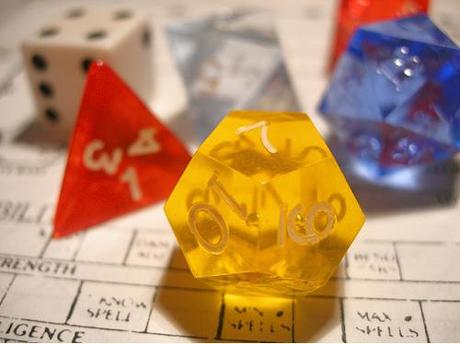
According to Michael Michalko Leonardi da Vinci was the first to write about the importance of introducing random and chance events to produce variation in one’s thinking patterns. In his highly recommended book Creative Thinkering – putting Your Imagination to Work he gives numerous exciting examples of using randomness to escape from standard thinking patterns.
His main hints are:
- It is impossible not to make connections
- Collect Interesting Stuff
- Use Pictures and Illustrations as Random Stimuli
- Use Your Imagination
- Take Thought Walks around your home, neighborhood or your workplace (A favorite of Steve Jobs)
- Blend Problems – work on several problems simultaneous
An embodiment of randomness is documented by Edward de Bono as a means to set up provocation to challenge dominant patterns – Random Input Technique. For most novices of creativity it is a rather exotic technique, but can produce rather exciting results.

Also TRIZ, a Russian creativity technique, uses randomness as a means to fight mental inertness. It is called Focal Objects.
- Take three totally different objects.
- Make a list of properties and features of the objects
- Make a connection between the features and properties of the focal objects and the problem you want to solve
For a more elaborate guideline to use the technique see here the explanation by ICG
Also writers use the technique of random inputs to overcome writers blocks and to create non-obvious stories. The Creative Writer’s Kit by Judy Reeves provides ice lolly sticks, at random to choose, with opening sentences, plot twist ideas and end images: the exercise is to connect them in a compelling story.
The technique can be used both with random words as with images. An random word generator can be found here, a random picture generator can be found here. In the latest version of Mindmanager a brainstorm module provides random images and pictures.
But there are much other possibilities to built randomness in your ordinary life:
- Visit a museum at random
- Go to a movie theater and watch the movie in the room you have tossed with a die
- Go to a training center, and follow the course which is given on the first floor, second room
- Buy a magazine you would never buy
- Read a different newspaper than you usually read
- Don’t plan your holiday, go with the flow, the weather and your spirit. Don’t make reservations in hotels or camping sites
- Change the way you commute to your work
- Engage in unusual encounters
- Organize a party for not-acquaintances
- Go to that theater you have never been to
- Engage in a conversation with an arbitrary person
- If you have two alternatives, throw a dime to decide what to do
- Eat your lunch with other people than from your department
- Avoid your standard hang-out places
- Buy a book you will never buy for yourself.
- Extend your library size and diversity as Francis Bacon, Voltaire, Jules Verne, Pyotr Tchaikovsky, Thomas Edison and Albert Einstein did.

Provoking randomness deliberately is all about escaping comfortable routines and creating chances and opportunities beyond one’s standard routines and world views.
Notice that search machines like Google remember your preferences for sites, products and topics. In doing so the use of search engines reinforces your appetite for some kind of opinions and thinking. To avoid that you could
- Use an other computer or IP-address
- Use different search engines. See here an overview of search engines.
- Subscribe to sites like StumbleUpon, which shows you sites which could be interesting for you
- If using a search engine look carefully or the results, they may reveal different interpretations of your search and may provide your with other interpretations or clues
Provoking randomness deliberately is a means to keep your thinking fresh, to avoid slipping into routine thinking. However, it has to be admit, to do that is leaving your comfort zone.
The comfort zone is a behavioral state within which a person operates in an anxiety-neutral condition, using a limited set of behaviors to deliver a steady level of performance, usually without a sense of risk. A person’s personality can be described by his or her comfort zones. Highly successful persons may routinely step outside their comfort zones, to accomplish what they wish. A comfort zone is a type of mental conditioning that causes a person to create and operate mental boundaries. Such boundaries create an unfounded sense of security. Like inertia, a person who has established a comfort zone in a particular axis of his or her life, will tend to stay within that zone without stepping outside of it. To step outside a comfort zone, a person must experiment with new and different behaviors, and then experience the new and different responses that then occur within their environment.
Don’t forget, some of the most powerful inventions were not deliberated scientific pursued or designed for, but were a result of an accident, a random event or a failed experiment. Most researchers would not notice the deviation to what were expected and denied the outcomes of the “failed” experiment. But some highly successful experimenters were prepared for unusual results and reflect on that. They used randomness as a tool to make progress.
To intensify your insight in the nature of randomness, read here what Wikipedia has to say about it.
Provoke randomness and to built into your daily routine as a Thinking Strategy could provide you with powerful insights.
Other blogs of ours about Thinking Strategies: Distancing, Backward Thinking, Think Inside the Box and many to come.
Why not subscribe for our next blog posts on Thinkibility here? We are a bit unpredictable;-)
Photo: ”Multicolored Cube” by Ventrilock, The Chaos Factor and The Great Hall Games.
